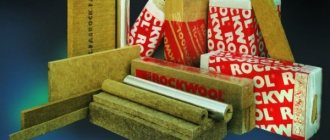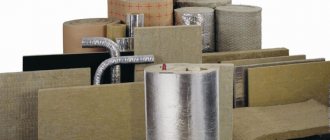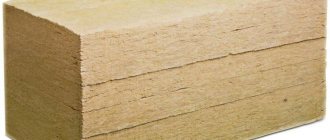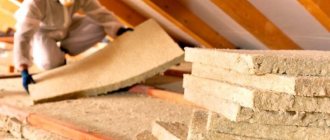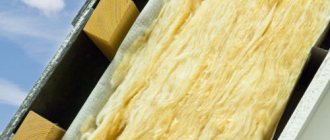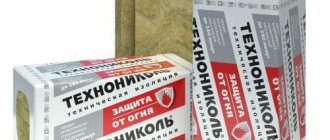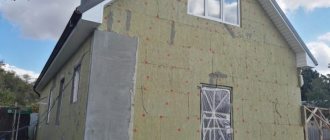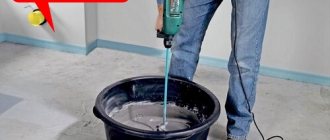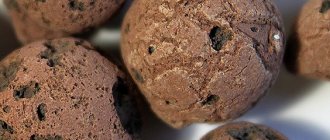The article was prepared with the participation of specialists from the ROCKWOOL company
Modern construction cannot be imagined without the use of various thermal insulation materials to minimize heat loss. In an energy-efficient house, there are no crazy energy bills even with a large area, since only the premises are heated, and not the street. One of the most popular thermal insulation materials is stone wool, used both on an industrial scale and throughout the private sector. And although this insulation is perhaps the most common, there is still a lot of speculation around it, and manufacturers endlessly face the same questions. In this article, with the help of ROCKWOOL specialists, we will look at the main characteristics of stone wool:
- Raw material base, production technology, release form.
- Scope of application.
- Technical and operational characteristics.
- Answers to questions from forum members
What is stone wool?
Rock wool is made from volcanic rock. In its natural form, it is a solid material, so that it takes on a “cotton” shape, it is melted and separated into fibers. Depending on the manufacturer, one or another technology may be used for this procedure (centrifugal or spinneret drawing, blowing, windrowing). Basalt treated in this way becomes free-flowing, and so that it does not crumble and so that it can be formed into a certain shape, the fibers are treated with an adhesive substance.
Phenol-formaldehyde resin is the same adhesive, in any case, it is used more often than its analogues. It glues the fibers together, thereby making layers of the required thickness. The stone wool is then treated with a special oil to make it water-repellent. The last stages of production are cutting and packaging of insulation.
Photo of facade insulation with stone wool
Glass wool
It is made from molten and foamed glass (usually cullet is used in production) with the addition of soda, limestone, quartz and dolomite fillers.
Disadvantages of glass wool
Phenol-formaldehyde resins are used to bind the components, which somewhat reduces the environmental friendliness of the resulting product. Glass wool mats are lightweight and can be compacted, which reduces transportation costs. They have high elasticity and flexibility, which allows them to be used for insulating non-standard structures with complex geometric shapes. Glass wool is resistant to combustion and biological destruction, while being fragile in relation to mechanical stress.
Types of stone wool
Also check out these articles
- Advantages of metal tiles
- We order a reliable ladder
- The choice of glue for furniture is an important and significant point
- Methods for decorating a bathroom ceiling that visually increase the volume of the room
Stone wool comes in different types. It is mainly divided into types based on density.
- Soft wool, also known as roll insulation. Its density ranges from 10-50 kg/m. cube Thermal conductivity coefficient is 0.033 W/m*S. Used in improving pipelines, frames, floors, partitions.
- A semi-rigid slab can have a density from 60 to 80 kg/m. cube Thermal conductivity coefficient is 0.039 W/m*S. It is often used for facades, roofs, laid on ceilings or in sandwich panels.
- A rigid slab has a density of 90-175 kg/m. cube Thermal conductivity coefficient is 0.046 W/m*S. This insulation is used for surfaces that are subject to significant mechanical stress. This could be the floor, roof, foundation, underground pipelines, etc.
At the time of purchase, the density of the material is always indicated in the form of letter markings. Soft stone wool is PM, hard stone wool is PZh, and semi-rigid stone wool is PP. The numbers that are written next to these letters with a hyphen indicate the density itself. Most often found on sale: PM-40, PM-50, PP-70, PP-80, PZh-100 and PZh-120.
In terms of geometric characteristics, there is no single classification, because different manufacturers may offer completely different products. Here, a lot depends on where exactly the insulation will be installed. But the thickness of stone wool is identical from different manufacturers. It is sold in thicknesses of 50, 100, 150 and 200 mm.
Photo of stone wool in rolls and slabs
There is another classification based on the type of packaging.
- Rolled stone wool can be plain or with foil on one side to increase heat-reflecting properties. The length of such material in a roll can be from 3 to 50 meters, and the width is 0.6-1.5 meters.
- In slabs - a typical option used for facades. The slabs are produced in widths of 60-120 cm and lengths of 120-150 cm.
- Shaped is one that has a round shell. It is used to insulate pipelines.
Crafts. MAAM Workshop
- Crafts from waste material
- Crafts made from natural materials
- Crafts for March 8th. Gifts for moms
- Origami
- Crafts for February 23. Gifts for dad
- Winter crafts
- Crafts made from fabric and threads
- Stained glass. Stained glass painting, crafts
- Spring crafts
- Master classes. Making DIY crafts with step-by-step photographs
- Teamwork. Collaborative work, collective creativity
- Summer crafts
- Pencil holder. DIY pencil holders
- DIY photo frames and frames
- Sun, sunshine. Crafts and drawings on a “sunny” theme
- Easter. Easter crafts.
- Space. Crafts for Cosmonautics Day
- Crafts for May 9
- Beading. Bead crafts
- Flowers. Flower themed crafts
- Topiary, tree of happiness. Master classes, works, photos
- Cardboard crafts
- Clay crafts
- DIY bracelets
- DIY headbands
- Plasticine, we sculpt from plasticine. Crafts
- Crafts and bouquets of sweets. Candy gifts, suite design, flowers
- New Year's crafts
- Wreath. DIY wreaths for the holidays, seasonal, New Year's
- Wire. Crafts made from chenille and ordinary wire
- DIY brooches
- Bell. Crafts and master classes
- Senior group
- Preparatory group
- Middle group
- Junior group
Showing publications 1-10 of 77789.All sections | Crafts, master classes. Making crafts with children
New
Master class “Postcard for Mother’s Day” Master class “Postcard for Mother’s Day”
Educator: Konyukhova S.R. Goal: to make a greeting card for Mother's Day. Objectives: -introduce children to the technology of making postcards in an unusual way; -develop attentiveness and consistency of correct...
Photo report on collective work in the pre-school speech therapy group of the Frosty Day kindergarten On the eve of the New Year holidays, kindergartens are being transformed. Teachers and parents decorate group cells with tinsel, toys, and lanterns. This task is mainly carried out by adults, since the work is labor-intensive and everything must be done perfectly. But children also want...
Properties and characteristics of stone wool
Stone wool is often compared to other types of similar material. Namely with glass wool, slag wool and mineral wool. Below are comparative characteristics that allow you to navigate one or another parameter of all types.
| Parameter | Stone wool | Mineral wool | Glass wool | Slag |
| Average fiber diameter (µm) | 5-15 | 4-12 | 4-12 | 4-12 |
| Fiber length | 20-50 | 16 | 15-50 | 16 |
| Thermal conductivity (W/m2*k) | 0,033-0,046 | 0,077-0,12 | 0,038-0,046 | 0,46-0,48 |
| Use temperature | From -190 to +700°C | -60 to +600°C | from -60 to +450°C | -60 to +250 |
| Sintering temperature | 700-1000 | 600 | 450-500 | 250-300 |
| Heat capacity | 500-800 | 1050 | 1050 | 1000 |
| Compressibility (%) | Up to 40 | 40 | 60 | 60 |
| Elasticity | 71 | 60 | 55 | 50 |
| Flammability class | NG - non-flammable | NG - non-flammable | NG - non-flammable | NG - non-flammable |
| Sound absorption | 0,87-0,95 | 0,75-0,95 | 0,8-0,92 | 0,75-0,82 |
| Vibration resistance | No | No | No | No |
| Binder (%) | From 2.5 to 10 | From 2.5 to 10 | From 2.5 to 10 | From 2.5 to 10 |
| Humidification per day (%) | 0,035 | 0,095 | 1,7 | 1,9 |
| Chemical resistance to water | 1,6 | 4,5 | 6,2 | 7,8 |
| Chem. alkaline resistance | 2,75 | 6,4 | 6 | 7 |
| Chem. resistance to acidic environment | 22 | 24 | 38,9 | 68,7 |
| Release of harmful substances | Yes, if there are harmful binders | Yes | Yes | Yes |
| Need for binders | Yes | Yes | Yes | Yes |
| Taunting | No | No | Yes | Yes |
Advantages and disadvantages
We recommend reading our other articles
- Features of using mortise locks
- Wood putty: varieties and features
- Sony TV from a reliable supplier
- Steel octagonal spacers
Experts note both the advantages and disadvantages of stone wool, so before buying it for insulation, you need to weigh the pros and cons. What are the advantages of stone wool?
- The material is lightweight, which makes it easy to carry and lay it while insulating the room.
- This is a time-tested insulation.
- High insulating properties.
- Stone wool is not afraid of temperature changes. Regardless of the weather, it does not expand or contract, holds its shape and retains its properties.
- The basic characteristics are the same regardless of the manufacturer. So, for example, insulation from Rockwool and Isobox have similar parameters and qualities, but differ in terms of price, additional raw materials used for production and other details. Hence the difference in price.
- The material is not flammable.
- Depending on the quality of the insulation, vapor permeability can vary from 0.3 to 0.55 mg/m hPa. The higher the indicator, the better this property is expressed.
- Laying stone wool is quite simple, even without practice.
Now about the disadvantages of stone wool.
- Contrary to misconceptions, it does not repel rodents. Mice and rats are not afraid of it and can live peacefully in it.
- The environmental friendliness of stone wool is often questioned due to the fact that the fibers are held together with resins during production. Manufacturers rarely explain what kind of resins they are, their exact composition and whether they are harmful, so the question remains open.
- When laying stone wool, dust is generated which is strongly recommended not to be inhaled. Therefore, you can only work with it in a respirator.
Photo of TechnoNIKOL and Rockwool stone wool
Requirements for the rough foundation
In order for the flooring material to serve the owners for the stated period, it is necessary to comply with the requirements for flooring under cork. More details:
1. The rough base must be perfectly level. A difference is allowed for each square. m no more than 2 mm. 2
It is important to waterproof the cork floor underneath with a special material with perforations to drain condensate. 3. Do not lay the plug on an unpolished concrete base.
Due to the pressure from above, the screed will rub the cork from below like sandpaper. A substrate is required.
Leveling the floor is not difficult - it is similar for laying all types of flooring.
Where is stone wool used?
Since the 20th century, stone wool has become widespread. Due to the fact that it is 95% natural material, it is used for insulation of a wide variety of types of buildings.
- Walls. This material is very popular as facade insulation. Thermal insulation properties help prevent heat loss in winter and keep cool in summer.
- Floors are often insulated with it. It allows you to make screeds and provides sound insulation.
- Roofs (flat and pitched) are partially insulated with this insulation. True, it is not recommended to use only stone wool, but it is suitable as part of the protection.
- Partitions inside rooms are often made using this material. It provides additional sound insulation.
- Load-bearing beams and columns, reinforced concrete floors, transit air ducts, cable and pipe passages can be made using stone wool. This provides fire protection and additional safety to the residents of the premises.
Areas of application of mineral wool insulation
This material of all varieties is used in many industries:
- in construction as a building component;
- insulation of facades, premises, various types of structures and pipes;
- sound insulation of the building (mainly basalt wool).
Mineral wool board has gained particular popularity in use. The material in this release form is easy to cut and convenient to transport. It is ideal for leveling surfaces and hiding wall imperfections.
The best stone wool manufacturers
Stone wool is produced by many manufacturers, but not all of them guarantee quality and durability. In order not to regret your purchase in the future, you should focus on leading manufacturers.
- TechnoNIKOL is a well-known manufacturer. TechnoNIKOL stone wool is released in series. For example, Rocklight slabs cost from $12 per cubic meter. Thermal roll is a roll, priced up to $23 per cubic meter. Technoacoustic – has excellent soundproofing properties. Price from 45 dollars.
- Isover is a French manufacturer. Well-known lines are Isover Classic, Isover KL-37 and Isover KT-37. Prices vary depending on product type and quantity, but on average you can find products for $13 and up.
- Isobox is an inexpensive type of stone wool from a domestic manufacturer. The products are produced in series (“Light”, “Inside”, “Facade”, “RUF”, “Extralight”) in automatic mode.
- Ursa is a well-known company whose material is used for insulation of residential, private houses, apartments, and industrial complexes. This company offers a new version of stone wool - Pure One, characterized by environmental friendliness and high performance. One roll will cost $23 on average. There are also products in slabs at about the same cost.
- Rockwool is the most popular brand. Many people have heard about him and this is not surprising. The manufacturer works on quality and durability. Famous lines of stone wool are Roof Butts and Cavity Butts. The average cost of a package or roll is $15-23.
- Knauf produces stone wool in a wide variety of types. Thermo Plate 0.37 is a good choice for floors, facades, and partitions. There are 12-24 slabs in a package. Approximate cost: 15-22 dollars. Tormo Roll is an analogue in the form of a roll. Recommended for insulation of any vertical and horizontal surfaces. The cost of one roll is from 18 dollars. There are also foil-coated products, their prices start at $15 and up.
Photo of wall insulation with stone wool
Basic rules of work
Mineral wool is mainly used to insulate exterior walls, attics and roofs. To insulate the foundation, it is better to use inexpensive, but at the same time high-quality polystyrene foam. It is more rigid and does not allow water to pass through.
If the correct installation technology is not followed, this will significantly affect the result. The material will quickly become unusable, and its high price will hit the budget hard in case of repeated repairs.
Before use, it is necessary to treat the facade with an antiseptic. This will prevent rotting and extend the life of the material. Foam concrete or brick must be cleaned of old paint and plaster before installation. The best time to carry out work is summer.
Before installation, it is necessary to remove window casings and door jambs. After installation, you will have to purchase new window and door cladding, as the thickness of the walls will increase noticeably.
There are two main methods of insulation:
- Dry. It is used only with frames made of wood or steel (lathing). The insulation is installed in the cells of the frame.
- Wet. In this case, installation is carried out using glue and disc dowels.
Glue and dowels are used more often in cases where it is planned to apply a finishing layer. The surface of the insulation can be puttied or plastered.
Dry installation
A frame is used for installation. The slats are installed so that the gap between them is 2 cm less than the width of the wool. This allows you to achieve maximum packing density. All work starts from the corners and smoothly moves to the center. In order for the result to be of the highest quality and the installation to be even, it is necessary to use a level and a cord that is stretched between the corners of the wall.
If a roll is used during installation, then installation is done from top to bottom. The slabs are installed only from bottom to top. The canvas must be secured with construction tape. To fix the result, holes are drilled and dowels driven into them.
The final stage is the installation of counter rails. This allows you to create a ventilated gap. The installation principle is to prevent the mineral wool joints from matching the corners of window and door openings.
If it is necessary to make the insulating layer thicker, the slabs are laid in several layers. It all depends on the need and preferences of the owner.
Wet method
The principle of this installation is to install the insulation on an adhesive solution that attaches the mineral wool to the wall. It is important that the glue allows steam to pass through well, otherwise condensation may accumulate in the material.
A layer of adhesive solution is spread on the wall using a notched trowel. After this, the slab must be pressed as much as possible against the wall. Once the row is installed, it must be additionally secured with disc dowels.
The final stage: glue is again applied to the insulation layer and the reinforcing mesh is fixed. This further strengthens the mineral wool slabs. After this, you can plaster and perform decorative work.
Reviews of stone wool
It cannot be said that any stone wool is good in use and durable. There are both positive and negative customer reviews.
- Mikhail Pavlov : “To insulate the house last year, we needed stone wool. The choice fell on TechnoNIKOL. This is a relatively inexpensive type, so in total we can say that we saved money. The cotton wool was used quickly, without problems. Among the shortcomings, I can note that it is very loose, although I took medium density. So you should be more careful when choosing. As for the qualities, the house became warmer, this was noted already in the first year after insulation.”
- Dmitry Zaitsev : “Rockwool is a well-known brand that produces stone wool. And the material is really high quality, very good. After insulation, the house is warm, cozy, there are no drafts, and even the dampness has disappeared. However, anyone who plans to buy this product should also purchase a pair of protective suits for work. This is truly dangerous insulation. On the skin it caused irritation, redness, itching, constant sneezing, and difficulty breathing. In general, nothing good - you can’t work with him without protection!”
- Elena Alexandrova : “Isobox stone wool is our choice for home insulation. Throughout the summer I was engaged in insulating the house both inside and outside. This insulation has both advantages and disadvantages. It insulates sound really well, retains heat, and the price is affordable. As for problems, a lot of dust flies from the stoves, which causes irritation, so it is better to use a respirator. The downside is that the insulation has uneven density over the entire surface. It crumbles and breaks a lot, and I’m sure this will affect its service life.”
Wet installation method
With this option, the main role is played by the glue that fixes the mineral wool slabs to the wall. It must have good vapor transmission so that condensation does not accumulate in the insulation. Be sure to take this point into account when purchasing. The market offers special adhesive compositions designed to work with stone wool.
The sequence of work using the wet method is visible in the figure.
Design for insulating walls with basalt wool and adhesive mortar
The installation of the slabs begins after installing the starting profile, which covers the slabs from below and prevents them from sliding until the adhesive composition sets.
A layer of glue is evenly distributed over the slab with a notched trowel and then pressed against the wall. Having installed a horizontal row, the insulation is additionally fixed with plastic disc-shaped dowels.
Having finished covering the wall, a layer of glue is also applied to the surface of the material and a fiberglass reinforcing mesh is embedded in it. Having leveled the surface with the rule, the solution is allowed to dry. The final operation is plastering.
